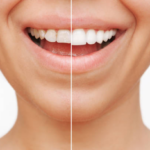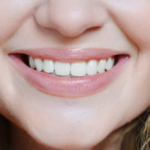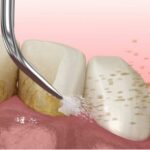- Teeth Roots Exposed: What’s Going On?
- Recognizing When A Root Is Exposed
- Typical Symptoms Of An Exposed Tooth Root
- Be On The Look Out For These Causes (and How to Avoid Them)!
- Options For Fixing Your Exposed Tooth Root
- Suggestions For An Exposed Root Treatment
- When Roots Are Exposed Too Far For An Easy Fix
- An Exposed Tooth Root Gets You To the Dentist; Now It’s Your Turn To Keep Your Teeth Healthy
- Contact Cimarron Family Dentistry For Your Next Dental Visit
What are Exposed Teeth Roots?

Exposed tooth roots are a visual sign of weakened enamel and dentin, the second and third layers of your teeth. Once the protective outer layer of teeth (enamel) is damaged or removed, you can see the roots of your teeth.
Exposed roots are an obvious sign that the inner part of your tooth has been compromised and weakened, which makes it susceptible to decay, infection, and fracturing.
With root exposure, there’s a risk of infection and bone erosion from acidic saliva. If you have exposed roots, we recommend you visit your dentist as soon as possible to take measures against further degradation. Read on to learn about exposed roots and how to prevent them!
Teeth Roots Exposed: What’s Going On?
When you crack or chip a tooth, the enamel usually cracks. But once that protective layer is broken, acid from food and drink can seep into the second layer of your teeth: the dentin. Dentin is porous and soft — it doesn’t have the same durability as enamel.
It can be compromised simply by brushing your teeth too hard or grinding them at night. One of the leading causes of exposed tooth roots is gum disease. It’s thought that bacteria released during gum disease can cause inflammation and lead to bone death around the roots of teeth.
If the gums recede far enough, they can expose the tooth roots.
Recognizing When A Root Is Exposed
If you’re unfamiliar with what an exposed tooth root looks like, it’s easily spotted using a mirror. Your tooth may look weird and longer than usual. You’ll notice that the top part of your tooth, the crown, dips down where the root begins.
The dip is where the gum and tooth meet, where the root is exposed. When a tooth is fully erupted and has an exposed root, it is also called a non-restorable tooth.
Typical Symptoms Of An Exposed Tooth Root
- Pain when chewing, especially with crunchy or hard food (e.g., apples, carrots, etc.)
- When you eat, you may develop sores or cuts in your mouth.
- Swelling in your gums
- Bad breath
- Sensitivity to hot or cold
- Sore tooth or gums
- Tooth sensitivity to a toothbrush or floss
Be On The Look Out For These Causes (and How to Avoid Them)!
Several factors can contribute to or cause an exposed tooth root. Luckily, you can avoid them or keep them in check by changing your oral hygiene routine. Here’s a checklist of what you can do to keep your tooth roots covered.
Brush Teeth Atleast Twice a Day
We know it’s a lot of work! But brushing twice a day is the best way to keep your teeth clean and healthy. It removes plaque, bacteria, and food particles that can lead to decay or gum disease.
Use a Soft Bristled Toothbrush
The American Dental Association recommends using a toothbrush with soft bristles that are not too stiff. You can try this test if you’re unsure if your toothbrush is too hard. Gently press the bristles of your toothbrush against your palm; if you feel a lot of pressure, the toothbrush is too hard.
Use Fluoride
Fluoride is a mineral proven to strengthen teeth and prevent decay. Using fluoride toothpaste can help strengthen teeth and prevent tooth decay. Avoid toothpaste containing Sodium Lauryl Sulfate (SLS), as it can harm oral health.
Avoid Teeth Grinding
Also called bruxism, this condition can weaken teeth and cause cracks or chips that lead to exposed tooth roots.
Drink a Mouthful of Fluids Before Going to Bed
Drinking water before bed can help prevent tooth decay and reduce the chance of grinding your teeth at night.
Options For Fixing Your Exposed Tooth Root
You can do a few things if you notice your tooth roots are exposed. First, don’t panic! It’s not a sign that you must go for extraction or surgery. Not yet, anyway. Some simple steps can help you get back to normal.
Root Canal
If your dentist notices the roots of your teeth are exposed, they may recommend a root canal treatment. Root canal therapy is usually used on teeth that have broken or cracked. The dentist will remove the damaged pulp from inside the tooth, clean out the inside of the tooth, and fill the root canal with a sealant or filling material.
Extraction
If your tooth is so damaged that it can’t be saved, your dentist may recommend extraction. This should be a last resort, as removing a tooth can cause your mouth to shift slightly and affect the health of your other teeth.
Suggestions For An Exposed Root Treatment
If you notice your tooth root is exposed, try not to clean it with a hard-bristled toothbrush. This can only cause more damage. Instead, your dentist may tell you to rinse the exposed tooth root gently with water until gum tissue grows back over it.
If your tooth root is exposed, it’s a good idea to avoid certain foods that can damage your teeth. Foods with hard or gritty textures, like popcorn kernels and apples, can cause damage to the exposed root. Root vegetables like carrots, yams, and potatoes are also tough and can cause damage.
Keep your dental health in check, and practice healthy oral habits.
When Roots Are Exposed Too Far For An Easy Fix
Dentists advise treating an exposed tooth root as soon as you notice; otherwise, it may be too late to repair. If the tooth is a permanent tooth, such as a molar or premolar, your dentist may remove the tooth and suggest the patient get an implant.
If the tooth is a baby tooth, your dentist may recommend removing it and applying a dental sealant to protect the tooth’s roots until it falls out. In some cases, a dentist may suggest removing the tooth if the tooth is causing irritation, such as when a wisdom tooth is growing sideways and causing headaches or earaches.
An Exposed Tooth Root Gets You To the Dentist; Now It’s Your Turn To Keep Your Teeth Healthy
Tooth root exposure is a sign of gum disease and weakened oral health. So, if you notice your tooth roots are exposed, it’s time to visit the dentist. Your dentist will likely recommend deep cleaning or scaling, which can help remove plaque and tartar that can cause gum disease.
They may also prescribe antibiotics if you have an infection. According to your dental health, your dentist may suggest a special diet that can help you keep your teeth and gums healthy. They may also recommend certain dental hygiene products, such as mouthwash or floss.
Keeping your teeth healthy means brushing and flossing regularly and visiting the dentist every six months for a checkup and cleaning. This way, you can keep your natural smile healthy and bright.
Contact Cimarron Family Dentistry For Your Next Dental Visit
Dentistry has advanced significantly during the past few decades. Various dental procedures are quick, effective, and minimally painful when performed by professionals.
At Cimarron Family Dentistry, we will explain each procedure in detail, whether you need a simple cleaning to get rid of tartar or a more complicated procedure like root planing for your gums or a root canal. Our friendly team and specialists are ready to help you.
Allow us to assist you in restoring your smile or maintaining healthy teeth. We simplify the process, so call us immediately to schedule an appointment!














